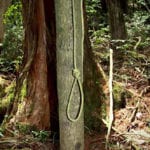 Miscellaneous
Miscellaneous  Miscellaneous
Miscellaneous  Politics
Politics 10 Lesser-Known Far-Right Groups of the 21st Century
 History
History Ten Revealing Facts about Daily Domestic Life in the Old West
 Weird Stuff
Weird Stuff 10 Everyday Products Surprisingly Made by Inmates
 Movies and TV
Movies and TV 10 Actors Dragged out of Retirement for One Key Role
 Creepy
Creepy 10 Lesser-Known Shapeshifter Legends from Around the World
 Animals
Animals 10 Amazing Animal Tales from the Ancient World
 Gaming
Gaming 10 Game Characters Everyone Hated Playing
 Books
Books 10 Famous Writers Who Were Hypocritical
 Humans
Humans 10 of the World’s Toughest Puzzles Solved in Record Time
 Miscellaneous
Miscellaneous 10 Ironic News Stories Straight out of an Alanis Morissette Song
 Politics
Politics 10 Lesser-Known Far-Right Groups of the 21st Century
 History
History Ten Revealing Facts about Daily Domestic Life in the Old West
Who's Behind Listverse?

Jamie Frater
Head Editor
Jamie founded Listverse due to an insatiable desire to share fascinating, obscure, and bizarre facts. He has been a guest speaker on numerous national radio and television stations and is a five time published author.
More About Us Weird Stuff
Weird Stuff 10 Everyday Products Surprisingly Made by Inmates
 Movies and TV
Movies and TV 10 Actors Dragged out of Retirement for One Key Role
 Creepy
Creepy 10 Lesser-Known Shapeshifter Legends from Around the World
 Animals
Animals 10 Amazing Animal Tales from the Ancient World
 Gaming
Gaming 10 Game Characters Everyone Hated Playing
 Books
Books 10 Famous Writers Who Were Hypocritical
 Humans
Humans 10 of the World’s Toughest Puzzles Solved in Record Time
10 Movies Filmed at Real-Life Asylums & Mental Hospitals
While many movies have been set within asylums, most have not gone so far as to use real-life ones during the shooting of the film. This list comprises some examples of productions that decided to opt for authenticity in their locations, if not necessarily in their depictions of life and treatment at such institutions.
The following well-known and lesser-known movies all spend significant amounts of their run-time within real asylums, either during or after their closure, using the asylum setting as a key element to the stories they tell.
Related: Top 10 Mental Disorders Hollywood Gets Totally Wrong
10 One Flew Over the Cuckoo’s Nest (1975)
Milos Forman’s adaptation of Ken Kesey’s 1962 novel sets the benchmark for more realistic depictions of asylum life. Filmed at Oregon’s Salem State Hospital (opened in 1883), it turns its setting into a power struggle between the autonomy and rights of the individual and the order and restrictions of the state. The free-spirited individual is personified by Jack Nicholson’s new patient McMurphy, while Louise Fletcher’s Nurse Ratched represents the coldly oppressive state and its unbreakable assurance that it always knows what’s best.
Produced by Michael Douglas, his father Kirk had bought the rights to the book and played the role of McMurphy in an earlier stage version. He intended to play McMurphy again in the movie but was too old by the time the much-delayed production began. The actors playing patients all slept in the ward used for filming, and real patients played extras seen around the asylum, as well as working as assistants during the shoot.
Shot on a tight budget, Nicholson took a percentage of profits for a reduced fee—a shrewd move as it became the fifth highest-grossing movie ever (at the time), with Nicholson and Fletcher winning Best Actor and Actress Oscars. It also won Best Picture, Best Director, and Best Adapted Screenplay.[1]
9 Doom Asylum (1987)
Richard Friedman’s horror takes us to the opposite end of the quality scale, one of many movies to treat the asylum setting as little more than a background to increase the creepiness of its lurid premise.
A former coroner is disfigured in a car accident and taken to an asylum where he lives in the basement after its closure, reappearing to stalk and kill the hapless teenagers who hang out in the abandoned building. The movie leans hard into its teen slasher vibe, presenting the stereotypical selection of geeky, goofy, sexy, and nerdy teens so beloved to rental horror fodder of the ’80s. One character wanders around the asylum in only a bikini, and a gang of faux punk rockers ensures it feels absolutely a product of its unique era.
The effects are gory and inventive in places, if never particularly convincing. Although many areas of the asylum (Essex Mountain Sanatorium in Verona, NJ, opened in 1907) used are bare and unremarkable, others are quite atmospheric, decayed, and littered with rusty old medical equipment. Ultimately, Doom Asylum succeeds in passing its own low bar of exceedingly silly, “popcorn” entertainment due to not taking itself remotely seriously. [2]
8 Session 9 (2001)
Brad Anderson’s movie casts the asylum itself as both a key part of the story and as one of its core characters. In a perfect location coup, the production secured Massachusetts’s Danvers State Hospital (opened in 1878), felt by many to be among the most iconic asylums in the U.S. It closed in 1992 (the movie states 1985), and the immense Gothic building is shown looming beautiful and grandiose, imposing and malevolent, right from the opening scene.
Gordon (a compelling central performance by Peter Mullan) leads a small team pitching for the contract to remove asbestos from the old asylum, promising to get the job done on an unrealistically tight two-week schedule. They encounter strange occurrences before one of the team goes missing, sowing seeds of suspicion and leading to increased pressure on Gordon, who appears to be gradually losing his grip on reality.
One team member finds a stash of old tape interviews with a patient who appears to be either mad or perhaps even possessed. These numbered “sessions” gradually lead up to a final, more malevolent persona being revealed in tape session no.9, hinting at a possible influence on the characters’ actions. Session 9 is a slow-burning, cerebral work that only rarely relies on shock value to achieve its chills. The genuine abandoned asylum provides a rich, evocative setting, with its genuine history deftly woven in among the fiction, perhaps more effectively than in any other asylum-set movie.[3]
7 Girl, Interrupted (1999)
Winona Ryder bought the rights to Susanna Kaysen’s 1993 memoir, recruiting director James Mangold to film the 1960s-set story in which she would star as a young woman diagnosed with personality disorder and committed to an asylum.
Reimagined as Claymoore Hospital, the movie was actually shot at Harrisburg State Hospital in Pennsylvania, which opened in 1851 and closed in 2006. Great use is made of the authentic setting, dressed to look much as it would have during the era depicted.
While individual characters conveniently fit into some of the stereotypes associated with asylum patients, the film’s setting and autobiographical origins lend it extra authenticity. It stands as a rare attempt to humanize rather than exaggerate and exploit the behavior and illnesses of its patients.[4]
6 Grave Encounters (2011)
A team of fake paranormal investigators spends the night in an abandoned asylum for a supernatural TV show in Colin and Stuart Ortiz’s debut. While “found-footage” horrors are ten-a-penny and ones set in asylums plentiful, Grave Encounters succeeds in providing uncomplicated shocks with a tight story, creepy visuals, and contemptible characters who gradually become more sympathetic as the terror of their situation sinks in.
We are shown the usual trickery of such shows, such as the cast arriving and immediately bribing a groundskeeper to pretend to have seen a ghost, wiring up doors to slam shut, and pretending to scream and jump at conveniently unseen apparitions. The premise for their show is that they will be locked inside the asylum overnight, and eventually, of course, increasingly strange things start to happen for real. While it doesn’t have anything to say about mental health, and the usual cliches are present, it does create an increasingly nightmarish scenario. Even the building itself appears to conspire against the team’s escape.
The asylum is referred to as Collingwood in Maryland, USA, but filming took place at Riverview Asylum in Coquitlam, Canada, which opened in 1913. Filming took place in disused areas, but it had not been empty long, hence the rather bland, modernized look, with little of the usual decay or damage. The found-footage approach and darkened hallways still conspire to create a creepy and claustrophobic atmosphere despite the lackluster setting.[5]
5 Shutter Island (2010)
Martin Scorcese’s movie was adapted from the 2003 novel by Dennis Lehane and sits somewhere between horror, psychological thriller, and police procedural. Two U.S. Marshals head out to Shutter Island (an anagram of “truths and lies”), dominated by the high-security Ashecliffe psychiatric hospital, to track down a murderous escaped patient but find they have unexpected personal links to the mysterious institution.
In reality, no asylum ever existed within the grounds of a war fortification. Still, the areas of the asylum itself are depicted accurately both inside and out, including details such as the grounds and solariums. Many external shots were composed at Medfield State Hospital in Massachusetts, which opened in 1896, and were composited with other locations and CGI to create the fictional asylum.[6]
4 The Dead Pit (1989)
An exploitative horror shocker by Brett Leonard (who later directed The Lawnmower Man), this sees a stereotypical “mad doctor” psychiatrist who experiments on his patients in the asylum’s basement killed by another doctor who then seals him and his remaining patients in the basement. Twenty years later, a new patient suffering from amnesia is admitted and inexplicably triggers an earthquake that cracks open the old basement, allowing the now-revived mad doctor and his slavering, zombie-like patients to run riot across the facility.
While many external scenes were filmed elsewhere, the idiosyncratic clock tower and many internal scenes were shot at the former high-security wing of Agnew State Hospital in Milpitas, CA (opened in 1906), lending the movie its only elements of credibility. Its representation of asylum routine largely consists of the typical aggressive dosing-up and fetishized hosing-down of eccentrically depicted patients.
The day room where several scenes are shot was the same one used for Green Day’s 1994 “Basket Case” video.[7]
3 Asylum (2005)
The author Patrick McGrath grew up in the long shadow of Broadmoor Criminal Asylum in Berkshire, UK, where his father was the Medical Superintendent, and mental illness is often worked into his books in some way. This is an adaptation of his 1996 novel of the same name.
The asylum featured is High Royds, at Menston, West Yorkshire, which opened in 1888 and only fully closed just two years before filming began. However, having been gradually disused over many years, the grounds and interiors were already somewhat overgrown and shabby. Filming during the fall, plants were spray-painted green to make it look more like the intended summer setting. High Royds was among the most spectacular and imposing of all British asylums. However, the interiors were modified slightly to appear more like an asylum for criminals (which it was not), including adding a barred iron gate to one of the corridors.
The movie stars Natasha Richardson, Marton Csokas, and Ian McKellen and addresses mental health, jealousy, adultery, and passion, albeit in a somewhat melodramatic and old-fashioned manner.[8]
2 The Professor and the Madman (2019)
Sean Penn stars as William Minor, who was committed to Broadmoor Criminal Asylum in Berkshire, UK, in 1872 after shooting dead a man that his mental health problems had caused him to believe was stalking him. While in the asylum, Minor contributed more than any other single author to providing definitions for what would become the first Oxford English Dictionary.
While Farhad Safinia’s movie uses two buildings to double as Broadmoor, St. Ita’s Asylum in Ireland is used for the majority of the interior and exterior shots. The huge building spans a staggering 1,630 feet (497 meters) and was the largest building project of any type built in Ireland while under British jurisdiction. It opened as the Dublin District Asylum in 1903 and closed to patients in 2017.[9]
1 Titicut Follies (1967)
Of all the films on this list, Frederick Wiseman’s documentary on Massachusetts’s Bridgewater State Prison for the Criminally Insane may be the most horrifying and upsetting of all, as it is all entirely real. His camera wanders the cells, corridors, surgeries, and grounds and often simply observes, occasionally allowing for interviews. It is an enthralling and appalling deep dive into both the minds, illnesses, and acts of the people incarcerated there and those of the staff, institutions, and wider society who felt this environment was a suitable place for human beings.
The Commonwealth of Massachusetts had the film banned outright, and it could only be legally shown to audiences composed of students and medical or legal practitioners until as late as 1992. The reason given was an “invasion of privacy” to those being filmed. However, many believed that the appalling scenes depicted and their reflection on the state’s provision were the primary motive.
Screened to the cast before filming began on several movies on this list, Wiseman’s passive camera and interviews allow patients and staff to speak largely unguided, staff often unwittingly damning themselves by their own uninterested attitudes to their work. Little vignettes tell sad or upsetting stories, such as the doctor who can’t be bothered to put his cigarette out even when force-feeding a patient on camera, dropping his ash down the tube. These images provide unvarnished insight into a broken and dysfunctional system from which meaningful rehabilitation seems almost impossible.[10]








